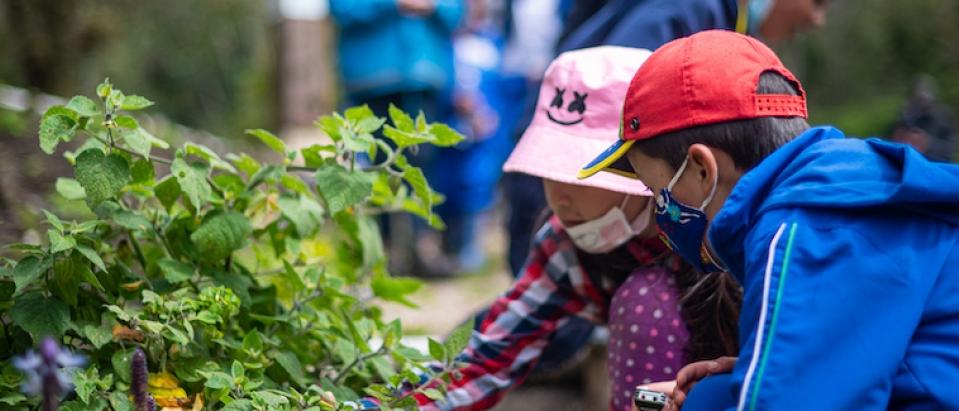
On Thursday, March 3, around 9:00 a.m., 27 kids from the Jaime Garzon School, Raizal campus, in the Chaquen theme park, a training and research space belonging to Subred Integrada de Servicios de Salud Sur E.S.E., in the Rio Blanco Watershed, getting ready the last This Is How Sumapaz Sounds recording day, a moorland sound memory exercise developed as part of Citizenship from arts and rights in Bogota, a Instituto Distrital de las Artes - Idartes and Fundación PLAN.
“What is this purple-leafed plant?” Juliana Rojas asks, an agronomist engineer from Subred Sur, to a group of children.
“Lettuce! Chard!” some ones reply, while Santiago, 8 years old, says his grandmother uses that plant when she’s sick.
At approximately 9:45 a.m., students, aged between 6 and 8, begin a tour in groups along the Chaquen Theme Park, in the Rio Blanco Watershed to discover the diversity of plants that could be found in its ecosystem such as tomatoes, beets, broccoli, sweet passion fruits, and seedlings having medicinal properties, such as boldo, which cures liver diseases by drinking it in an infusion.
As they descend through the hill terraces, the children’s voices intertwine with the wind sound touching the crowns. Esmeralda, 7 years old, likes it, this is the nicest thing about living here. The strong river’s current was the most audible thing, although the song of some birds such as the blue gallinule and the cormorant could also be heard intermittently. Typical sounds of Sumapaz.
Kids carry their own documentation tool, all of them ready to record sounds, collect messages and ideas. Some of them have a small two-color digital camera – some green and yellow and others green and pink – while other ones carry tape recorders and, a few, their parents’ cellphones.
“What plants have we seen so far?” “Cape gooseberries, onions, corn, chard, potatoes, tomatoes!” Say some ones while the other ones taste or touch seedlings and vegetables.
Children finish the fourth and last this is how Sumapaz sounds podcast chapter on Connecting Bridges between the Countryside and the City with what they hear, recognize and interpret.
This project, developed with the Juan de La Cruz Varela School, Tunal Alto campus, in the Sumapaz River Watershed, and the Jaime Garzon School, Raizal campus, in the Blanco River Watershed, in Sumapaz borough, is committed to the recognition of the rural art and culture role through a sound memory exercise.
this is how Sumapaz sounds is a podcast composed of four chapters rising as a result of a series of laboratories where children, families and communities explored, from the corporeal, sensory and poetic part of the arts, the peasant oral tradition and its ecosystem’s traits.
Sumapaz covers about 50% of the city of Bogota, is a completely rural borough and contains the heart of the world’s largest moorland. This territory protection and recognition, particularly by its inhabitants, is the reason why Idartes and Fundación PLAN decided to develop this component.
The four-laboratory process sought to recognize the identity processes children and adolescents from Sumapaz through the collection of artistic manifestations, expressions, feelings, practices and knowledge.
“Through oral tradition, such as couplets, rhymes, songs and stories, people can reboot their memory and allow art to renovate the territory’s imagination. It is important children recognize the peasant art and culture role in the Sumapaz community social fabric construction” says Catalina Valencia Tobon, Idartes director.
The chapters Memory and territory, Art and rurality, I’m peasant in the Bogota’s countryside and Relationships between countryside and city were introduced at the Rural Art Meeting, held on March 17 at the Juan de la Cruz Varela School, Tunal Alto campus, in Sumapaz.
“We are moved in the Fundación PLAN by hearing the children and adolescents’ stories who took part in this process. Collecting their voices and stories makes possible to the rural life to be seen in the multiple cultures of Bogota. This artistic and sound exercise helps us to position the rural identity of people living in Sumapaz”, said Angela Beatriz Anzola de Toro, executive president of Fundación PLAN.
This is how Sumapaz sounds chapters can be found at Idartes en casa and at Fundación PLAN’s channel.